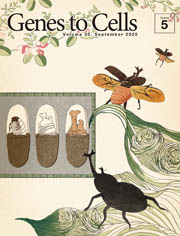
November 2025
When we visualized single-cell RNA sequencing data using UMAP, a pattern serendipitously emerged that resembled two carp ascending a waterfall. We sought to enclose this image within a refreshing Japanese confection. We are grateful to Prof. Fumiki Katsuoka and Dr. Takanori Hidaka (Tohoku University) for providing the idea and the UMAP visualization.

September 2025
In the larval head of the Japanese rhinoceros beetle (Trypoxylus dichotomus), the horn primordium is stored as a sac-like structure with wrinkles inscribed in a specific pattern. When the larva molts into a pupa, hemolymph is pumped into this sac, causing the wrinkles to stretch and the sac to expand, which results in the formation of the horn. Multiple research groups in Japan have investigated the three-dimensional morphogenesis of this horn. For further information, see the following publications: Matsuda et al. (2024) Development 151: dev202082, DOI: 10.1242/dev.202082; Matsuda et al. (2021) Sci. Rep. 11: 1017, DOI: 10.1038/s41598-020-79757-2; Adachi et al. (2020) Sci. Rep. 10: 18687, DOI: 10.1038/s41598-020-75709-y; Ohde et al. (2018) PLoS Genet. 14: e1007651, DOI: 10.1371/journal.pgen.1007651. As if celebrating the emergence of the beetles, the veins of the nearby leaves trace patterns reminiscent of the wrinkles in the horn primordium.